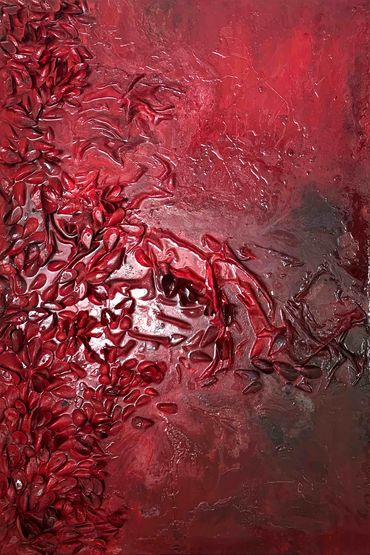CATHARSIS: AN ECSTATIC PROCESSION TO DELOS
22 July – 24 September 2022
Arnados Tinos
Dimitris Alithinos
Dafni Athanasopoulou
Under the Auspices of Tinos Festival and the Municipality of Tinos
With the support of Ballis Tinos and Estia Services
Organised by EuroMare
Curated by Alia Tsagkari
Catharsis: An Ecstatic Procession to Delos is a contemporary art exhibition project that develops in two distinct parts, which intersect at the instinctive articulation of a modern “mythology of catharsis” that re-enchants the disenchanted reality.
Under the dazzling Aegean light and the purifying Tinian wind, the in-situ realisation of the 228thConcealment by the renowned Greek artist Dimitris Alithinos constitutes the first part of the exhibition. Pertaining to the noted Concealments, an ongoing project that began in 1981 as a “concealment of memory” and involves an international network of 227 sites, the Concealment of a large-scale installation in the earthy entrails of Arnados constitutes the secular homologue of the ritual offerings that preceded the primaeval rituals of purification (catharsis).
Absorbing the specific regional circumstances of the selected location, the sculptural intervention into the bowels of Arnados emerges as a vertiginous descent into the depths of abyss, where ritual sacrifice and sacred ecstasy, death and eroticism coexist. The outcome of the violent rupture of the Tinian earth and the subsequent insertion of 300 bottles of red wine, 2 wooden boxes, 41 clay disks impressed with extracts from the Hymn to Apollo, and a voluminous semi-reflective boulder, the gapping pit of the Concealment embodies the structural violence of death and eroticism.
The fragmented chthōn (earth) that enwraps the object of the Concealment – sacrifice – becomes the signifier of the generative and destructive powers that govern art and life. As the installation sinks into the ground, it transcends the decay and mortality and enters an inaccessible extra-sensory sphere. Thus, it breaches the boundaries between the visible the invisible, sharpening the ceremonial dimensions of the Concealment as a ritual of mediation between the secular and the transcendental. The selected location, opposite to the sacred island of Apollo, the god of light, intensifies these ritual elements. From the immaterial light to the stygian darkness, the Concealment exemplifies the primaeval procession from the Sun – Father – Phallus to the Earth – Mother – Womb. Concurrently, the immersion of the work into the earth signals its distancing from the physical world, its sacrifice.
Inciting a series of associations with libations of wine and blood offerings, the Concealment transforms through the independent and personal work of Dimitris Alithinos into a palimpsest of archetypal signs/symbols that visualises a ritual process of writing. In addition to this, the incorporation within the 2 wooden boxes of personal items, which the visitors will offer/sacrifice during the course of the exhibition, not only underlines the sacrificial aspects of the installation, but also reinstates its initial conception as a “concealment of memory”. More specifically, as a form of repository for the benefit of future generations, the 228th Concealment forcefully reasserts the urgent demand for the preservation and continuation of life, while simultaneously expressing anguish over the danger of the extinction of the human species.
In this ritual schema, the visceral anatomical plasticity of the sanguinary red surfaces of Dafni Atha’s Proliferation series supplements the ritual character of the exhibition as a preparatory stage leading to catharsis. Combining painting, photography and prints, the series focuses on the visual exploration of the anatomical micro-variations of heterogeneous surfaces, textures, natural elements and body parts. Through the macrophotographic rendering of various found objects, specific details are appropriated, which, perpetually repeated, produce abstract compositions of irregular elements. Drops of undissolved paint, resins with wet textures, solid shellacs, Mytilidae and Ostreidae become the visceral elements of large-scale hemorrhagic compositions. The abject anatomical veracity, combined with the organic, squishy finishes, triggers an unsettling correlation with blood sacrifices that preceded catharsis.
The exhibition’s point of departure is the mystical, visceral and chthonic practices of purification, which were taking place in the temple of Poseidon and Amphitrite at Kionia on Tinos island before the ancient pilgrims proceeded to Delos. Interweaving fundamental mythological structures with contemporary visual approaches, Catharsismaps the organic interrelation between the two sacred islands and vital religious centres of antiquity, Tinos and Delos.
Facing the infinity of the Aegean Sea and the sacredness of Delos, the exhibition as a contemporary catharsis aims to cleanse the externally imposed “filters” that obscure the close interrelation between the two islands. In this manner, the show highlights the timelessness of the island’s primordial, archaic and mysterious past and outlines an ecstatic procession to Delos.
















Copyright © 2025 Alia Tsagkari - All Rights Reserved.
This website uses cookies.
We use cookies to analyze website traffic and optimize your website experience. By accepting our use of cookies, your data will be aggregated with all other user data.